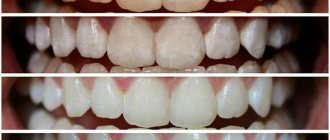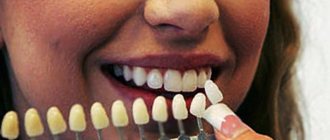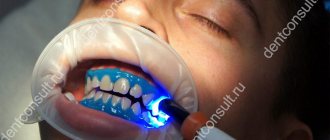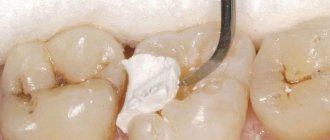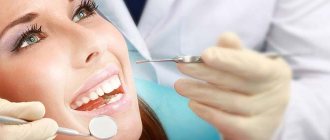Laser whitening is the latest modern dental procedure. Marketing offers customers whiter teeth in a shorter period of time than any other whitening solution. It's safe and fast. This procedure may cost a little more than other methods, but the patient will no longer have to worry about it.
In today's society, teeth whitening is a very popular cosmetic procedure, it is non-invasive and creates a beautiful white smile that is very attractive. As people begin to age, it is natural for their teeth to darken. This occurs from smoking, as well as from eating foods or liquids that can cause stains. Laser whitening can help solve some of these problems.
What is the essence of the method?
Laser teeth whitening is one of the most common ways to solve the problem of discolored teeth. This procedure has gained more popularity in recent years because it is safe and will not damage the patient's gums or tooth structure. Since people cannot perform this procedure at home, they must consult a dentist at this time, the dentist will determine which type of method is most suitable for them.
Content:
- What is the essence of the method?
- What can patients expect from this method?
- Advantages and disadvantages
- Stages of the procedure
- What to expect after the procedure?
- Difference of Methods
- Risks of Teeth Whitening
- Relevance of the method
What can patients expect from this method?
One of the main advantages of laser whitening is that from start to finish, the entire procedure takes about an hour before any difference is noticeable. Laser teeth whitening is not recommended for people who have bleeding gums, sensitive or other serious dental problems. Also, this procedure is not recommended for pregnant women and young people under the age of sixteen.
It is also possible that the patient's teeth will be whiter than expected. This is not a long-term problem due to the fact that laser whitening does not have permanent results. With this in mind, some spots may appear which may require additional laser treatments. This, of course, leads to further costs. However, the immediate results are worth the investment.
Advantages and disadvantages
The advantages are that one procedure takes 15-60 minutes and is performed under dental supervision. Cons: increased likelihood of sensitivity, can damage tooth enamel and also high price.
The fact is that laser whitening is still a very new technology, and the battle over the science, including response time, increased sensitivity, and danger to the pulp, is still in jeopardy.
Contrary to the high-tech idea that lasers themselves can remove dirt from teeth, the laser itself does not do the cleaning. Dentists must apply a peroxide paste—hydrogen peroxide or carbamide peroxide—and then heat it with argon or a CO2 laser. Laser whitening involves removing all stains after 2-4 thirty-minute procedures (once every 10 days).
It is a misconception that the laser method will permanently whiten teeth in one go. It is not uncommon for clients to report a slight difference in whiteness after just one session. However, even with multiple sessions averaging 30 minutes each, the process is still significantly faster than other methods. While laser use appears to be fairly safe, there has been controversy in the past over sensitivity, amount of peroxide, and chemical combination. Some believe that the laser's heat may permanently weaken the pulp, while others worry about enamel erosion in patients.
The Canadian Dental Association notes that laser procedures have simply "understood little scientific evaluation" and should be studied more thoroughly before making judgments, while the ADA noted that most of their studies report no additional long-term benefits of using lasers for whitening.
Perhaps the biggest downside to laser whitening is its price, as it is the most expensive whitening option, especially since repeat appointments will likely be required.
Ultimately, it depends on the patient's budget and time frame, and whether the personal dentist agrees that this is a good idea.
Indications and contraindications
The indication for laser whitening is darkening of tooth enamel, and the list of contraindications is much longer:
- age up to 18 years (very thin enamel);
- During pregnancy and breastfeeding;
- gum disease in the acute stage;
- erosion of tooth enamel;
- hypersensitivity, allergic reactions or the presence of individual intolerance to the components of the whitening gel;
- the presence of extended teeth in the oral cavity and a large number of filled teeth;
- period of orthodontic treatment;
- pathological or age-related tooth wear;
- poorly installed fillings, microcracks in teeth, porous enamel.
It is important to remember that before whitening, you should treat your gums and teeth, perform professional teeth cleaning: remove tartar and remove plaque, treat and polish the interdental spaces, apply a special fluoride-containing preparation that strengthens tooth enamel. Only after such professional training will the procedure give a truly beautiful and snow-white smile.
Stages of the procedure
The main stages of laser teeth whitening:
- Screening. It is recommended that pregnant women and teenagers avoid this procedure if possible. If tooth discoloration is a serious problem, teens can whiten their teeth with close supervision from a dentist. During the initial screening, the dentist will also check the condition of the gums to expose a significant portion of the tooth root. If this is the case, the teeth may whiten somewhat unevenly because the roots of the teeth are resistant to whitening. Your dentist may be able to suggest alternatives to this method.
- Preliminary processing. The next step for the dentist is to clean your teeth. All cavities are treated and filled because otherwise the bleaching solution may leak through the cavity into the inside of the tooth.
- Drug treatment. Any form of teeth whitening may cause temporary sensitivity, especially in individuals who already have sensitivity in their teeth. For this reason, your dentist may prescribe non-steroidal anti-inflammatory drugs before your first whitening session.
- Bleaching. When it is time to begin the procedure, the patient will sit back in the dentist's chair as usual, and the dentist will use a rubber or plastic seal to keep the mouth open. The dentist will then apply a barrier to your gums to protect them from the whitening solution. This barrier is often applied as a gel that hardens to a protective rubber-like layer. Once the gums are completely protected, the dentist will use a syringe to apply the whitening agent to the front of the teeth. When all teeth are whitened with the laser, the dentist will allow the substance to sit for a few minutes and then wipe off the bleaching agent with a small vacuum tool. He will then apply a new layer of compound and repeat the process a full three times.
- Ending. The patient knows he has reached the end of the session when the dentist thoroughly rinses his mouth, then carefully removes the protective layer from the gums.
How does ZOOM 4 whitening work?
A standard session consists of several steps:
- The doctor examines the oral cavity and determines the desired shade of enamel using the VITA scale.
- A special protective composition is applied to the gums and inner surface of the lips to prevent burns, and the patient is wearing glasses to protect against ultraviolet radiation.
- The surface of the working area is disinfected and dried.
- The first layer of whitening gel is applied, an activating lamp is brought to the mouth - this stage lasts 15-20 minutes.
- The lamp is turned off, and the dried excess composition is carefully removed from the teeth.
- If necessary, the cycle of application and activation with light is repeated up to a maximum of 3 times.
- A remineralizing gel is applied to the enamel to reduce tooth sensitivity.
The standard concentration of the whitening composition is 25% hydrogen peroxide with additional components that reduce the impact on the enamel. This gel is as safe as possible for hardware procedures and does not cause severe irritation.
In advanced cases, one session at the dentist’s office is not enough, and doctors additionally prescribe ZOOM home whitening kits. They usually include a thermoplastic mouthguard + several syringes with a daily dosage of lightening gel.
These sets have several features:
- There are day (9% hydrogen peroxide) and night mouth guards (16% carbamide peroxide);
- The recommended time for wearing the plates is 30 minutes twice a day;
- the standard number of doses is calculated for 9 and 18 applications;
- To control it, you will have to go to the dentist several times a week.
The maximum result of such whitening is 4 shades on the VITA scale, but as an additional measure, home kits have received good reviews from both patients and doctors. At the same time, it is possible to lighten a smile by 8 tones or more without harm to health only in dentistry using patented equipment.
What to expect after the procedure?
After a whitening session, the patient may find that there is increased tooth sensitivity, especially in the first few days. It depends on the patient; some report numbness and several patients have compared it to being hit by a hammer. The dentist may prescribe medications to avoid or reduce sensitivity, and of course the sensitivity will wear off after a few days. You should also see your dentist if you notice that your gums are white or sore, but this is less common than sensitivity. The whitening process is not permanent. Teeth can be re-stained, especially by cigarettes, drinks such as coffee or tea, or certain foods. A follow-up whitening treatment may need to be scheduled; whitening effectiveness lasts six months or up to several years.
Preparation for laser whitening
A week before the procedure, you need to visit the dental clinic for a consultation. During this visit, the dentist will examine the oral cavity, assess the condition of the enamel and gums, and determine any contraindications. If caries is present, therapeutic treatment is prescribed.
Laser whitening cannot be performed if there are carious lesions in the dentition. Oxygen atoms will penetrate deep into the tooth tissue through carious cavities, reaching its nerve, causing severe pain. Subsequently, such exposure will accelerate the process of tooth decay. To avoid this, laser whitening is carried out only after sanitation (treatment) of the oral cavity. After examination and treatment, the patient undergoes hygienic cleaning, during which pigment plaque and tartar are removed. Dental plaque makes our teeth several shades darker. Professional cleaning allows you to determine their natural color. Upon completion of the procedure, fluoride-containing solutions are applied to strengthen the enamel. After hygienic cleaning, several days must pass for the soft tissue of the gums to recover from microtraumas received during the cleaning process. After which you can begin laser whitening.
Difference of Methods
There is an opinion that the brighter and whiter the smile, the younger and happier a person will feel. But is the pursuit of a bright, sparkling smile as safe and effective as dental brochures claim? Cosmetic dentists are increasingly coming under fire when they make exaggerated claims about expensive laser whitening procedures.
Whitening toothpastes have been criticized for containing abrasive particles that can damage tooth enamel, and some researchers say hydrogen peroxide, the most commonly used whitening agent, may be carcinogenic and weaken teeth.
There are three main approaches to whitening. Toothpastes containing anti-staining agents or hydrogen peroxide cost slightly more than regular toothpastes and are used by hundreds of thousands of people every day.
At-home whitening kits that involve placing a hydrogen peroxide solution in whitening brackets that patients wear on their teeth at night for two weeks. They claim to whiten teeth by six or eight shades and are the second most popular treatment.
The last, most expensive method is laser teeth whitening, in which a hydrogen peroxide solution applied to the patient's teeth is exposed to strong light, which speeds up the healing process. Taking between 15 minutes and one hour, this procedure claims to lighten teeth by up to 11 shades.
But what is the evidence that these treatments work? While whitening toothpastes can slow down the staining process, a recent study in the British Dental Journal found that the vast majority did not live up to claims that they made teeth lighter.
Whitening toothpastes remove stain particles and are much less abrasive than they once were, but claims that they whiten teeth are questionable. Some contain hydrogen peroxide, but by the time you use it, it is so weak and unstable that the effect is often minimal. However, whitening procedures can be very effective and concerns about their safety have been largely alleviated.
Whitening kits and laser whitening significantly whiten teeth. Each method can make teeth up to 11 shades lighter. The main difference is that at-home whitening takes up to two weeks, while laser treatment takes about 30 minutes.
Types of lasers used
Two types of lasers are used to activate whitening mixtures:
- Diode - it is characterized by high catalytic efficiency, which is ensured by the power of the device.
- Green (KTR) - when exposed to it, a pronounced alkaline environment is formed on the surface being treated. This removes pigments that darken the enamel, as well as bacteria, and disinfects the oral cavity.
It is difficult to say which laser is preferable, since their efficiency is approximately equal. With a green laser, slightly less exposure time is required, so the procedure is faster.
Comparison with other types of whitening
Let's look at the most commonly used methods of enamel lightening and compare them with laser techniques:
- Ultrasonic whitening. Recognized as less effective. Contraindicated in patients with cardiac arrhythmias or pacemakers.
- Chemical. Significant results are never achieved in one go. It is possible to whiten only 3–5 tones, and the session must be repeated 2–4 times. This means that whitening takes much longer. Special trays for the reagent can damage the gums mechanically, and the chemical mixture in them can cause burns.
- Photobleaching. Very long-lasting technology compared to laser. But in terms of the whitening effect, the methods are comparable.
- Zoom technology. Effective, gentle technique. The procedure lasts 60–80 minutes.
Laser technology provides the fastest results with high efficiency. The procedure is also one of the most gentle. The choice of technique should be entrusted to the dentist who will perform the procedure. He will advise the most suitable one, taking into account the condition of the teeth, oral cavity and general health of the patient.
Risks of Teeth Whitening
There is little evidence that hydrogen peroxide demineralizes teeth, making them weaker. Some researchers have claimed that the chemical is a potential carcinogen. However, when applied correctly, it should only come into contact with the enamel, which is dead anyway.
The main risk of hydrogen peroxide, whether used at home or at the dentist, is that it irritates and whitens the gums. For this reason, dentists use whitening solutions very carefully.
However, whitening methods will not work for everyone. Enamel staining is also caused by antibiotics such as tetracycline, which discolor the enamel itself. Cosmetic dental practices claim—often unrealistically—that laser whitening can also remove this type of staining. In fact, in these cases there is only a 10 or 20% chance of bleaching.
Best materials of the month
- Coronaviruses: SARS-CoV-2 (COVID-19)
- Antibiotics for the prevention and treatment of COVID-19: how effective are they?
- The most common "office" diseases
- Does vodka kill coronavirus?
- How to stay alive on our roads?
Dental care
To maintain the results for a long time, it is very important to adhere to the rules of oral care:
- thorough oral hygiene, including flossing;
- Dentists recommend using a soft or medium-hard toothbrush, preferably with natural bristles;
- to give up smoking;
- periodic professional teeth cleaning;
- mandatory visits to the dentist once every six months;
- In the first days after the procedure, you must completely avoid coloring products (coffee, black tea, wine, etc.).
To prevent re-staining of the enamel, you should continue to follow these recommendations, and then your impeccable snow-white smile will delight you and those around you for a long time.
There is a misconception that the laser technique and the Zoom technique are the same thing. In reality, this is not the case, although the laser and Zoom teeth whitening techniques are similar.
Relevance of the method
As whitening has become more popular, some cosmetic dentists have begun using lasers or similar light sources to speed up the chemical reaction of the whitening solution. This method whitens faster and requires fewer whitening sessions. Unlike peroxide whitening, new laser whitening cannot be done at home; it must be completed under the supervision of a qualified dentist.
All forms of whitening work by releasing oxygen ions from the teeth whitening gel, which gently removes stains from the teeth. The laser simply removes stains faster. Another advantage of the laser is that (depending on the type of laser used) it is easier to use to whiten one tooth at a time. This is useful when one tooth is more discolored than the surrounding teeth.
More fresh and relevant information about health on our Telegram channel. Subscribe: https://t.me/foodandhealthru
We will be grateful if you use the buttons:
The principle of laser operation in medicine and dentistry
The laser is a high-tech invention that has existed in medicine for more than 65 years. In 2021, scientists even celebrated a kind of anniversary - it was 65 years [1] ago that the first laser device was invented by the community of Soviet specialists.
In fact, laser is an acronym that stands for light Amplification by Stimulated Emission of Radiation. Translated from English it means “light amplification using stimulated emission.” Today, devices based on the action of so-called stimulated radiation are successfully used in surgery, cosmetology, therapy, dermatology and, of course, dentistry.
As for the dentistry industry, here laser devices are used in therapy, periodontics, surgery, and for physical procedures. In the treatment of deep caries, for minimally invasive operations on soft tissues (for example, gingivoplasty), root canal treatment. They help prevent bleeding, eliminate pathogenic microflora, and remove necrotic tissue. They provide high sterility, prevent the development of complications after treatment, and promote rapid tissue healing.
However, most often patients hear about them when it comes to teeth whitening. Indeed, lasers have found wide application in aesthetic dentistry. With their help, one of the most successful office or professional methods, based on the action of the photothermal effect, became possible. What is it and how does it work?
In simple terms, doctors use such a device on a gel that is previously applied to the enamel and contains oxidizing agents - hydrogen peroxide or carbamide. The device emits laser light with a wavelength of 800 nanometers or more (in modern devices), as well as blue or green dense radiation of a spectrum safe for enamel. By acting on the gel, the laser increases its temperature, promotes the accelerated release of free radicals[2] and active oxygen, which destroy any inorganic acids. As a result, superficial and deeply ingrained pigment is removed from the teeth without damaging the tissue.
On a note! The operating principle of a dental laser is to oscillate a beam of light between lenses installed in the device. As soon as such lenses gain maximum power, they emit a beam that penetrates deeply into tissue, absorbs water and destroys chemical bonds in molecules.


